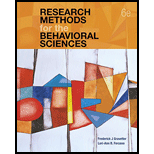
In addition to the key words, you should also be able to define the following terms:
Third-variable problem
Placebo
Directionality problem
Mundane realism
Confounding variable
Experimental realism
Random process
The meaning of the terms related to experimental research
Answer to Problem 1E
Solution:
The definition of all the terms is as follows:
Third variable problem: many a times it is observed that when two variables are studied and a relation of cause and effect is observed in them, there may actually be a third variable, that causes both the variables to change, and thus it appears to us that they are related. Though the actual cause of the change in both the variables is a third variable, this is not considered in the research.
Directionality problem: It is important to know what the cause is and what the effect is, merely getting a relation does not help. When there are two variables it is important to understand, which one is the stimulus and which one of them is the response. Setting the direction of research is important. When there is confusion with regards to the direction it is called directionality problem.
Confounding variable: Any extraneous variable in a research which is not controlled may start varying with the independent variable, and cause to affect the result, that is an extraneous variable if not controlled turns to be a confounding variable. Such a confounding variable that distorts the relation of dependent and independent variable in the research actually is a big threat to the internal validity of the research.
Random process: these are the processes that are time varying functions. Each time unit is assigned an outcome. This process can be used to find average over a period of time. The reason it is called random is because the evolution of the process is random, it is not deterministic.
Placebo: It is the effect observed when a group in the experiment is a given a dose that is not the treatment and causes not effect on the experimental units of this group. The reaction of all these units is observed, since they think that they have received the treatment. This effect is called Placebo effect, and the group that is assigned placebo is called placebo group of control group.
Mundane realism: This implies to the fact that up-to what extent the materials and the processes and the steps used in the research are similar to the real world events. This helps in the generalization of the research outcomes to the real world. It helps in measuring the external validity. It lets us know how close to reality the research is.
Experimental realism: It is the extent to which the situations created in the research are impactful on the participants. It mostly relates to psychology because it tells how participants feel during the experiment, does it match with the real-world experience and if yes, up to what extent does it match.
Explanation of Solution
Conclusion:
Thus by defining various terms related to experimental study, we get better insight of what an experimental study is, what problems are encountered in it, and what is like creating an environment that matches the real world, or a scenario that feels the same.
Want to see more full solutions like this?
Chapter 7 Solutions
Research Methods for the Behavioral Sciences (MindTap Course List)
- please find the answers for the yellows boxes using the information and the picture belowarrow_forwardA marketing agency wants to determine whether different advertising platforms generate significantly different levels of customer engagement. The agency measures the average number of daily clicks on ads for three platforms: Social Media, Search Engines, and Email Campaigns. The agency collects data on daily clicks for each platform over a 10-day period and wants to test whether there is a statistically significant difference in the mean number of daily clicks among these platforms. Conduct ANOVA test. You can provide your answer by inserting a text box and the answer must include: also please provide a step by on getting the answers in excel Null hypothesis, Alternative hypothesis, Show answer (output table/summary table), and Conclusion based on the P value.arrow_forwardA company found that the daily sales revenue of its flagship product follows a normal distribution with a mean of $4500 and a standard deviation of $450. The company defines a "high-sales day" that is, any day with sales exceeding $4800. please provide a step by step on how to get the answers Q: What percentage of days can the company expect to have "high-sales days" or sales greater than $4800? Q: What is the sales revenue threshold for the bottom 10% of days? (please note that 10% refers to the probability/area under bell curve towards the lower tail of bell curve) Provide answers in the yellow cellsarrow_forward
- Business Discussarrow_forwardThe following data represent total ventilation measured in liters of air per minute per square meter of body area for two independent (and randomly chosen) samples. Analyze these data using the appropriate non-parametric hypothesis testarrow_forwardeach column represents before & after measurements on the same individual. Analyze with the appropriate non-parametric hypothesis test for a paired design.arrow_forward
 Glencoe Algebra 1, Student Edition, 9780079039897...AlgebraISBN:9780079039897Author:CarterPublisher:McGraw Hill
Glencoe Algebra 1, Student Edition, 9780079039897...AlgebraISBN:9780079039897Author:CarterPublisher:McGraw Hill Big Ideas Math A Bridge To Success Algebra 1: Stu...AlgebraISBN:9781680331141Author:HOUGHTON MIFFLIN HARCOURTPublisher:Houghton Mifflin Harcourt
Big Ideas Math A Bridge To Success Algebra 1: Stu...AlgebraISBN:9781680331141Author:HOUGHTON MIFFLIN HARCOURTPublisher:Houghton Mifflin Harcourt


